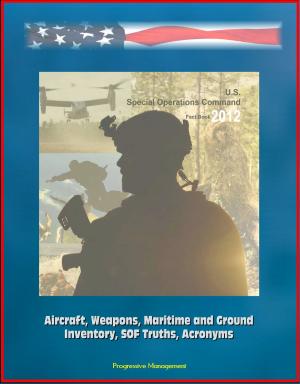Integrating the Unmanned Aircraft System (UAS) Into the National Airspace System
Nonfiction, Science & Nature, Technology, Aeronautics & Astronautics, History, Military, Aviation| Author: | Progressive Management | ISBN: | 9781301344871 |
| Publisher: | Progressive Management | Publication: | September 18, 2012 |
| Imprint: | Smashwords Edition | Language: | English |
| Author: | Progressive Management |
| ISBN: | 9781301344871 |
| Publisher: | Progressive Management |
| Publication: | September 18, 2012 |
| Imprint: | Smashwords Edition |
| Language: | English |
In the last 10 years, the unmanned aircraft system (UAS) has captured the public's imagination and fascination with their ability to provide instantaneous video feeds of military and covert CIA operations in faraway places like Afghanistan and Iraq.
The rapid proliferation of the UAS and the eventual redeployment of current systems deployed to Afghanistan and Iraq will require the Federal Aviation Administration (FAA) to provide unrestricted unmanned aircraft access within the National Airspace System (NAS). The Department of Defense (DoD) requires routine access to the NAS to execute directed missions, meet training requirements, and perform necessary testing to meet the Joint Force Commander's (JFC's) established mission priorities. Over the past several years, the DoD has been able to execute a small portion of UAS flights in the NAS but current rules and regulation do not facilitate seamless integration with manned aircraft.
The purpose of this study is to show that although the DoD and the FAA recognize the importance of integrating manned and unmanned aircraft within the NAS, there are many challenges and gaps that must be bridged to facilitate successful integration. The most important challenge to overcome when integrating manned and unmanned aircraft into the same airspace is safety.
CONTENTS * ABREVIATIONS * CHAPTER 1 * INTRODUCTION * Purpose * Thesis Statement * Limitations * CHAPTER 2 * BACKGROUND * The Federal Aviation Administration (FAA) * Unmanned Aircraft System (UAS) * UAS Defined * Historical Evolution of UAS * Current UAS * The Future of UAS * CHAPTER 3 * OPERATIONAL ENVIRONMENT * Classifications of UAS * The National Airspace System * Airspace Classifications * Air Traffic System (ATS) * Operational Requirements * CHAPTER 4 * ANALYSIS AND DISCUSSION * Safety Standards * Target Level of Safety (TLS) * System Reliability * Airworthiness Certification * Regulatory Challenges * Technical Challenges * Sense and Avoid (SAA) Technology Surveillance Systems * Frequency and Bandwidth * Operational Challenges * Interoperability * Air Traffic Operations * Lost-Link Procedures * CHAPTER 5 * RECOMMENDATIONS * Safety Standards * Updating Regulations * Technology Integration * Operational Improvements * CONCLUSION * APPENDIX A * CLASSES OF AIRSPACE * APPENDIX B * LEVELS OF AIRWORTHINESS * BIBLIOGRAPHY
In the last 10 years, the unmanned aircraft system (UAS) has captured the public's imagination and fascination with their ability to provide instantaneous video feeds of military and covert CIA operations in faraway places like Afghanistan and Iraq.
The rapid proliferation of the UAS and the eventual redeployment of current systems deployed to Afghanistan and Iraq will require the Federal Aviation Administration (FAA) to provide unrestricted unmanned aircraft access within the National Airspace System (NAS). The Department of Defense (DoD) requires routine access to the NAS to execute directed missions, meet training requirements, and perform necessary testing to meet the Joint Force Commander's (JFC's) established mission priorities. Over the past several years, the DoD has been able to execute a small portion of UAS flights in the NAS but current rules and regulation do not facilitate seamless integration with manned aircraft.
The purpose of this study is to show that although the DoD and the FAA recognize the importance of integrating manned and unmanned aircraft within the NAS, there are many challenges and gaps that must be bridged to facilitate successful integration. The most important challenge to overcome when integrating manned and unmanned aircraft into the same airspace is safety.
CONTENTS * ABREVIATIONS * CHAPTER 1 * INTRODUCTION * Purpose * Thesis Statement * Limitations * CHAPTER 2 * BACKGROUND * The Federal Aviation Administration (FAA) * Unmanned Aircraft System (UAS) * UAS Defined * Historical Evolution of UAS * Current UAS * The Future of UAS * CHAPTER 3 * OPERATIONAL ENVIRONMENT * Classifications of UAS * The National Airspace System * Airspace Classifications * Air Traffic System (ATS) * Operational Requirements * CHAPTER 4 * ANALYSIS AND DISCUSSION * Safety Standards * Target Level of Safety (TLS) * System Reliability * Airworthiness Certification * Regulatory Challenges * Technical Challenges * Sense and Avoid (SAA) Technology Surveillance Systems * Frequency and Bandwidth * Operational Challenges * Interoperability * Air Traffic Operations * Lost-Link Procedures * CHAPTER 5 * RECOMMENDATIONS * Safety Standards * Updating Regulations * Technology Integration * Operational Improvements * CONCLUSION * APPENDIX A * CLASSES OF AIRSPACE * APPENDIX B * LEVELS OF AIRWORTHINESS * BIBLIOGRAPHY















